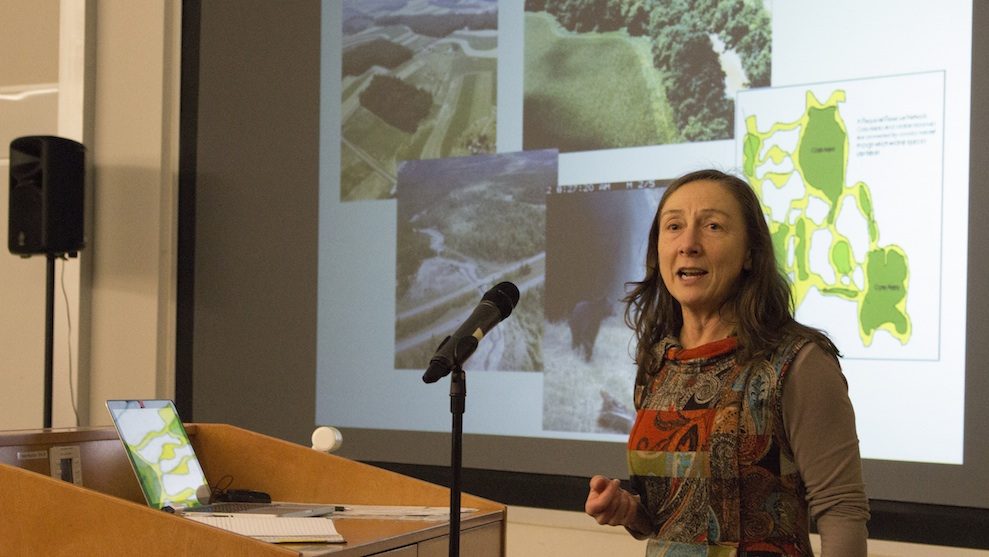Environment
Suburbia or sprawl? Halifax faces a crucial decision
Experts discuss the HRM's ability to contain its growth and create a greenbelt

caption
David Donnelly, an environmental lawyer from Toronto, explains greenbelts to Halifax residents at Dalhousie University.
caption
David Donnelly, an environmental lawyer from Toronto, explains greenbelts to Halifax residents at Dalhousie University.Halifax needs to combat the “sprawl on steroids” that has hit major Canadian cities, like Toronto, by encouraging downtown growth, according to one environmental lawyer.
David Donnelly was one of four panellists speaking at “The Halifax Greenbelt” event held at Dalhousie University’s Kenneth C. Rowe Management Building on Wednesday night. The discussion centred on the municipality’s ability to minimize its suburban sprawl.
Alongside Donnelly were Karen Beazley, an environmental studies professor at Dalhousie; Dusan Soudek, the Director of Environment with Canoe Kayak Nova Scotia; and Graziella Gbrac, the Executive Director of Village on Main in Dartmouth. Our HRM Alliance, which is based out of the North End’s Ecology Action Centre, organized the event. The Alliance’s goal is to further the case for a greenbelt — a protected zone of environmentally sensitive and valuable land — around the municipality.
The majority of the room’s 120 seats were filled and the crowd was mainly grey-haired, with a sprinkling of younger individuals mixed throughout the room. Attendees were clearly invested in the issue of a greenbelt; the evening ran half an hour over the planned end time and even so, there wasn’t enough time for everyone to ask their questions.
Donnelly, who spoke first, stated that the greenbelt around Toronto has been an economic and environmental boon to the region. He said a similar greenbelt in the Halifax Regional Municipality would combat the “sprawl on steroids” he sees in the area.
“We have essentially killed urban sprawl in southern Ontario,” he said, going on to say that if a greenbelt can do that for the area around Toronto, it’s a no-brainer for the HRM.
“Halifax is an octopus,” Donnelly said, comparing the HRM’s boundaries to downtown Toronto, which has “a somewhat rectangular shape, and that equals efficiency.”
He cited a Stantec report that showed the cost of living in urban versus suburban households. Homes in suburban areas cost cities over twice as much as those closer to the city centre.
“I have four kids and I go to bed every night terrified about what urban sprawl really means,” he said.
When a man from the audience waxed poetic about his suburban life in Hammonds Plains, Donnelly became more animated.
“Halifax has to get over its phobia around growth; we’re not saying 100 storey buildings with a tennis court on its roof like Dubai,” he said. “People go mad in isolation and suburbia is a form of isolation.”
Beazley said a greenbelt would protect wildlife in the region, such as the local moose population. Moose are seeing their woodland living spaces shrink as human influence spreads outwards from Halifax and the highways linking cities around the province.

caption
Dalhousie University’s Karen Beazley outlines the implications of a greenbelt upon local wildlife.“We need regional plans,” she said. “We need a map of urban growth boundaries to direct development away from important biodiversity areas.”
Gbrac suggested that investors could forgo development in HRM’s outskirts in favour of building in underdeveloped urban areas like central Dartmouth.
“Don’t grow there, grow here,” she said, pointing to empty parking lots in well-located neighbourhoods that were lacking an efficient use of space.
The conversation will continue this spring when the municipality’s Halifax Green Network Plan hosts public consultations on how to go forward conserving private and public land.

